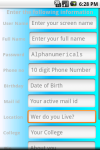
Yippey! I am selected for Google Summer of Code 2011. Many people asked me what my gsoc project was about and after iterating the explanation a few times, I thought the better idea to brag about it was to blog about it. 🙂
How I came across this Project?
I was browsing through various organization projects tagged Android in the list of accepted organizations for gsoc and came across Komodo open lab. Their project ideas page listed some interesting project ideas and the Indoor Geocaching game based on tagin! specifically caught my attention, mainly because it was similar in some aspects to Cygnus. After some chats with mentor on the irc channel about the project idea and implementation, I was completely hooked into the idea.
What is the project about?
Okay, time to get into the business of explaining what this project is really about.  Geocaching is a popular adventure game played all around the globe by people of all ages. Basically, it is a high-tech treasure hunting game played throughout the world by adventure seekers equipped with GPS devices. Statistics say that there are over 5 million geo-cachers on the face of the planet.
Geocaching is a popular adventure game played all around the globe by people of all ages. Basically, it is a high-tech treasure hunting game played throughout the world by adventure seekers equipped with GPS devices. Statistics say that there are over 5 million geo-cachers on the face of the planet.
Now the idea of Indoor Geocaching as the name suggests is to take geocaching indoors. The technique used in outdoor geocaching cannot be extended for behind the doors geocaching as GPS tracking need a clear line of sight to the GPS satellites, so their performance is reduced in shaded environments.In fact, most GPS devices don’t work indoors. So we need a completely new approach to tackle this problem.

That’s where tagin! kicks in. It is an open source, location tagging engine that may be used to create indoor location-based services (LBS) and applications. tagin! works by collecting various WiFi fingerprints of a particular location. A WiFi fingerprint is the pattern of signal strengths of a collection of WiFi access points visible in a particular area. This signal strength pattern tends to vary from place to place, that is how tagin! can identify different locations (e.g., rooms) even when they are covered by the same group of WiFi access points.
I have explained the basic functionality of the application in as many as 2 steps. If you are interested in knowing more about the application or features planning to be implemented, you can read from my wiki page.
- User login/sign up into the Indoor Geocaching application.
- He can choose to either find or hide a cache. In case he chooses to hide a cache, he can do so by going to the location of cache, storing the fingerprints and submitting them to the server. To find a cache, the user downloads the fingerprints associated to the cache and use the navigational interface displayed by the app to get himself there.
The application involves a server side as well as a client side and I have been selected to work on the client side application in Android for the project. I am looking forward to an exciting summer of coding. 🙂
cheers,
Primal Pappachan









